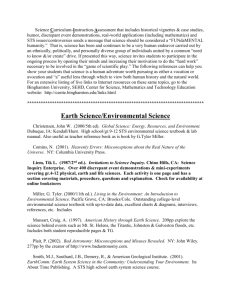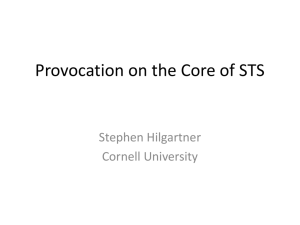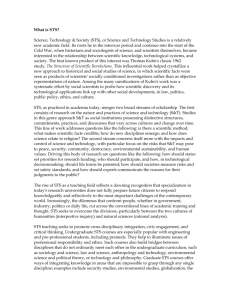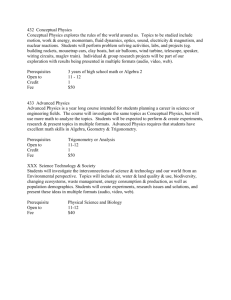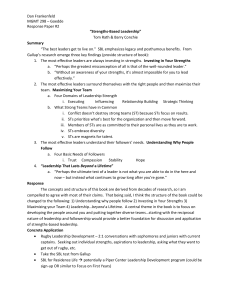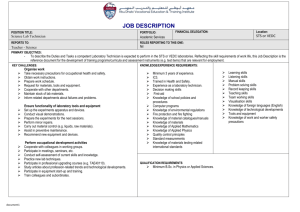Grade 7 Science Outcomes: Heat and Temperature (Unit C
advertisement
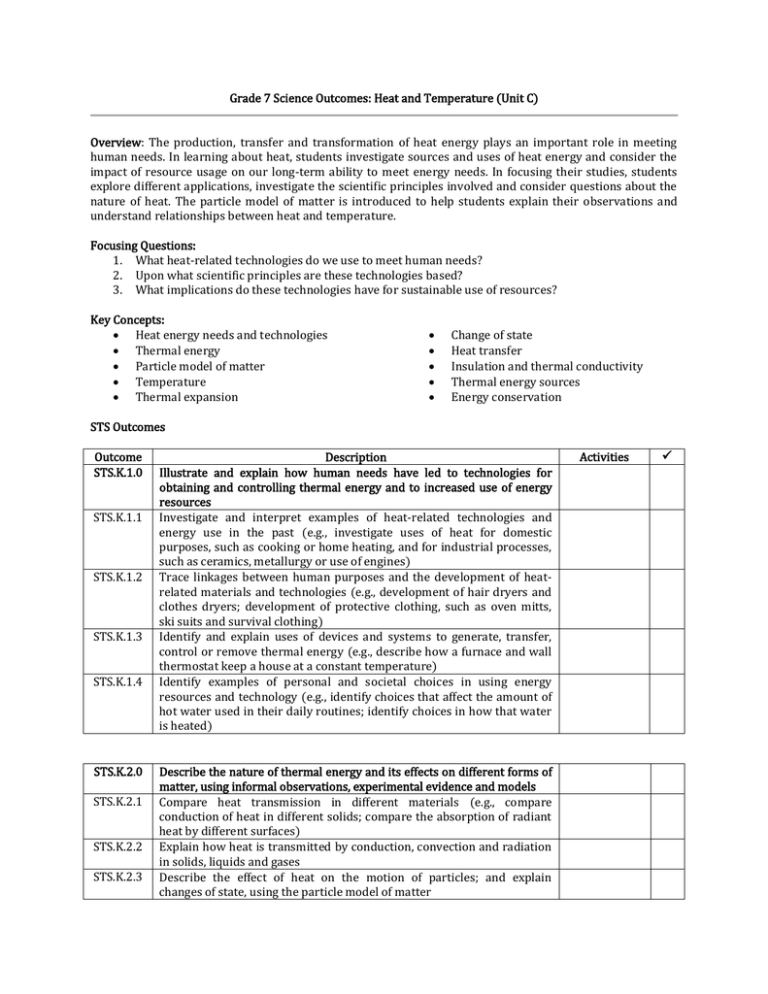
Grade 7 Science Outcomes: Heat and Temperature (Unit C) Overview: The production, transfer and transformation of heat energy plays an important role in meeting human needs. In learning about heat, students investigate sources and uses of heat energy and consider the impact of resource usage on our long-term ability to meet energy needs. In focusing their studies, students explore different applications, investigate the scientific principles involved and consider questions about the nature of heat. The particle model of matter is introduced to help students explain their observations and understand relationships between heat and temperature. Focusing Questions: 1. What heat-related technologies do we use to meet human needs? 2. Upon what scientific principles are these technologies based? 3. What implications do these technologies have for sustainable use of resources? Key Concepts: Heat energy needs and technologies Thermal energy Particle model of matter Temperature Thermal expansion Change of state Heat transfer Insulation and thermal conductivity Thermal energy sources Energy conservation STS Outcomes Outcome STS.K.1.0 STS.K.1.1 STS.K.1.2 STS.K.1.3 STS.K.1.4 STS.K.2.0 STS.K.2.1 STS.K.2.2 STS.K.2.3 Description Illustrate and explain how human needs have led to technologies for obtaining and controlling thermal energy and to increased use of energy resources Investigate and interpret examples of heat-related technologies and energy use in the past (e.g., investigate uses of heat for domestic purposes, such as cooking or home heating, and for industrial processes, such as ceramics, metallurgy or use of engines) Trace linkages between human purposes and the development of heatrelated materials and technologies (e.g., development of hair dryers and clothes dryers; development of protective clothing, such as oven mitts, ski suits and survival clothing) Identify and explain uses of devices and systems to generate, transfer, control or remove thermal energy (e.g., describe how a furnace and wall thermostat keep a house at a constant temperature) Identify examples of personal and societal choices in using energy resources and technology (e.g., identify choices that affect the amount of hot water used in their daily routines; identify choices in how that water is heated) Describe the nature of thermal energy and its effects on different forms of matter, using informal observations, experimental evidence and models Compare heat transmission in different materials (e.g., compare conduction of heat in different solids; compare the absorption of radiant heat by different surfaces) Explain how heat is transmitted by conduction, convection and radiation in solids, liquids and gases Describe the effect of heat on the motion of particles; and explain changes of state, using the particle model of matter Activities STS.K.2.4 STS.K.2.5 STS.K.3.0 STS.K.3.1 STS.K.3.2 STS.K.3.3 STS.K.3.4 STS.K.3.5 STS.K.3.6 STS.K.4.0 STS.K.4.1 STS.K.4.2 STS.K.4.3 Distinguish between heat and temperature; and explain temperature, using the concept of kinetic energy and the particle model of matter Investigate and describe the effects of heating and cooling on the volume of different materials, and identify applications of these effects (e.g., use of expansion joints on bridges and railway tracks to accommodate thermal expansion) Apply an understanding of heat and temperature in interpreting natural phenomena and technological devices Describe ways in which thermal energy is produced naturally (e.g., solar radiation, combustion of fuels, living things, geothermal sources and composting) Describe examples of passive and active solar heating, and explain the principles that underlie them (e.g., design of homes to maximize use of winter sunshine) Compare and evaluate materials and designs that maximize or minimize heat energy transfer (e.g., design and build a device that minimizes energy transfer, such as an insulated container for hot drinks; evaluate different window coatings for use in a model home) Explain the operation of technological devices and systems that respond to temperature change (e.g., thermometers, bimetallic strips, thermostatically-controlled heating systems) Describe and interpret the function of household devices and systems for generating, transferring, controlling or removing thermal energy (e.g., describe in general terms the operation of heaters, furnaces, refrigerators and air conditioning devices) Investigate and describe practical problems in controlling and using thermal energy (e.g., heat losses, excess energy consumption, damage to materials caused by uneven heating, risk of fire) Analyze issues related to the selection and use of thermal technologies, and explain decisions in terms of advantages and disadvantages for sustainability Identify and evaluate different sources of heat and the environmental impacts of their use (e.g., identify advantages and disadvantages of fossil fuel use; compare the use of renewable and nonrenewable sources in different applications) Compare the energy consumption of alternative technologies for heat production and use, and identify related questions and issues (e.g., compare the energy required in alternative cooking technologies, such as electric stoves, gas stoves, microwave ovens and solar cookers; identify issues regarding safety of fuels, hot surfaces and combustion products) Identify positive and negative consequences of energy use, and describe examples of energy conservation in their home or community Skill Outcomes A.IP.1.0 A.IP.1.1 A.IP.1.2 Ask questions about the relationships between and among observable variables, and plan investigations to address those questions Identify science-related issues (e.g., identify an economic issue related to heat loss in a building) Identify questions to investigate arising from a problem or issue (e.g., ask A.IP.1.3 A.IP.1.4 A.PR.1.0 A.PR.1.1 A.PR.1.2 A.PR.1.3 A.PR.1.4 A.AI.1.0 A.AI.1.1 A.AI.1.2 A.AI.1.3 A.AI.1.4 A.CT.1.0 A.CT.1.1 A.CT.1.2 a question about the source of cold air in a building, or about ways to prevent cold areas) Phrase questions in a testable form, and clearly define practical problems (e.g., rephrase a general question, such as: “How can we cut heat loss through windows?” to become “What effect would the addition of a plastic layer have on heat loss through window glass?” or “How would the use of double- or triple-paned windows affect heat loss?”) Design an experiment, and control the major variables (e.g., design an experiment to evaluate two alternative designs for solar heating a model house) Conduct investigations into the relationships between and among observations, and gather and record qualitative and quantitative data Identify data and information that are relevant to a given problem or issue Select and integrate information from various print and electronic sources or from several parts of the same source (e.g., describe current solar energy applications in Canada, based on information from a variety of print and electronic sources) Use instruments effectively and accurately for collecting data and information (e.g., accurately read temperature scales and use a variety of thermometers; demonstrate skill in downloading text, images, and audio and video files on methods of solar heating) Carry out procedures, controlling the major variables (e.g., show appropriate attention to controls in investigations of the insulative properties of different materials) Analyze qualitative and quantitative data, and develop and assess possible explanations Compile and display data, by hand or computer, in a variety of formats, including diagrams, flow charts, tables, bar graphs and line graphs (e.g., construct a database to enter, compare and present data on the insulative properties of different materials) Identify, and suggest explanations for, discrepancies in data Identify and evaluate potential applications of findings (e.g., the application of heat transfer principles to the design of homes and protective clothing) Test the design of a constructed device or system (e.g., test a personallyconstructed heating or cooling device) Work collaboratively on problems; and use appropriate language and formats to communicate ideas, procedures and results Communicate questions, ideas, intentions, plans and results, using lists, notes in point form, sentences, data tables, graphs, drawings, oral language and other means (e.g., use electronic hardware to generate data summaries and graphs of group data, and present these findings) Defend a given position on an issue, based on their findings (e.g., defend the use of a particular renewable or nonrenewable source of heat energy in a particular application) Attitude Outcomes 1. Show interest in science-related questions and issues, and pursue personal interests and career possibilities within science-related fields (e.g., apply ideas learned in asking and answering questions about everyday phenomena related to heat; show interest in a broad scope of science-related fields in which heat plays a significant role) 2. Appreciate that scientific understanding evolves from the interaction of ideas involving people with different views and backgrounds (e.g., appreciate Aboriginal home designs of the past and present that use locally-available materials; recognize that science and technology develop in response to global concerns, as well as to local needs; consider more than one factor or perspective when making decisions on STS issues) 3. Seek and apply evidence when evaluating alternative approaches to investigations, problems and issues (e.g., view a situation from different perspectives; propose options and compare them when making decisions or taking action) 4. Work collaboratively in carrying out investigations and in generating and evaluating ideas (e.g., choose a variety of strategies, such as active listening, paraphrasing and questioning, in order to understand other points of view; seek consensus before making decisions) 5. Demonstrate sensitivity and responsibility in pursuing a balance between the needs of humans and a sustainable environment (e.g., recognize the distinction between renewable and nonrenewable resources and the implications this has for responsible action; objectively identify potential conflicts between responding to human wants and needs and protecting the environment) 6. Show concern for safety in planning, carrying out and reviewing activities (e.g., demonstrate concern for self and others in planning and carrying out experimental activities involving the heating of materials; select safe methods for collecting evidence and solving problems)

